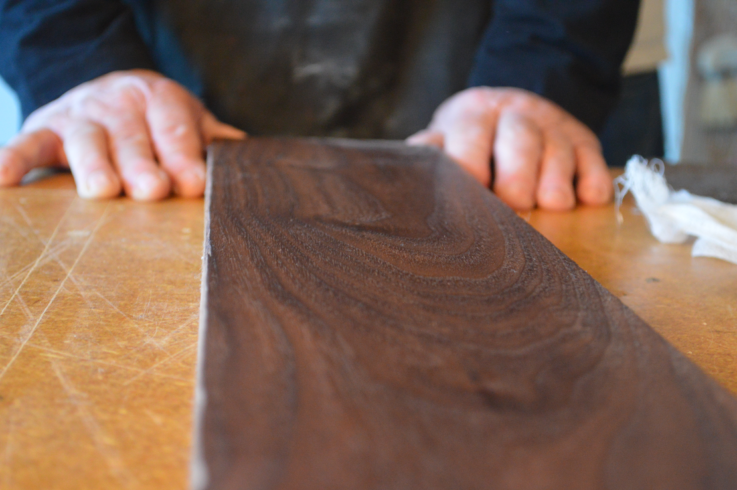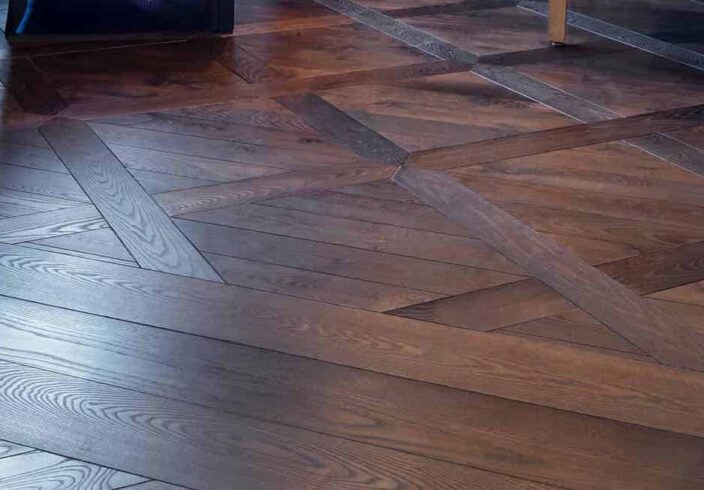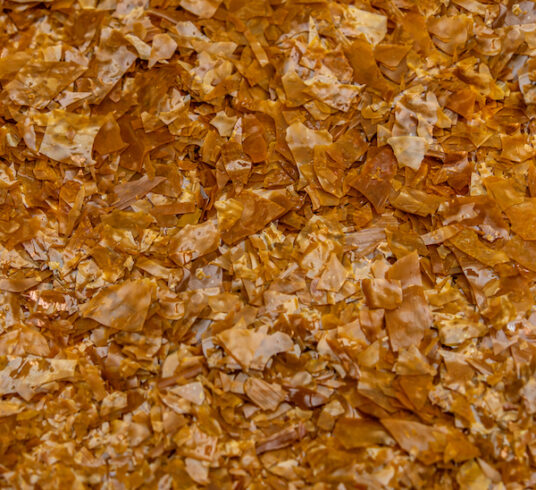There are a number of all-natural finishes for wood and some are durable enough for floors, outdoor furniture, and decks. Others are not waterproof and are for indoor wood projects only. Some are food-safe and toy-safe for countertops and children’s toys.
Natural finishes don’t look usually like your typical polyurethane coatings. Oils darken wood but produce a matte look. The waxes add a little sheen. Shellac is naturally quite shiny. The Danish soap finish will give you the most invisible look.
Linseed Oil paint can look similar to a regular matte paint, while Milk Paint & natural pigments can be used as a paint or stain/wash.
This article contains affiliate links, upon purchase I make a small commission at no extra cost to you.
Part 1: Drying Oils (aka Penetrating Oils)
Linseed, tung, refined hemp, soy, and poppy seed oil, are all-natural oils that on their own can be used to seal and protect hardwood floors (both solid wood and unfinished engineered wood). They are usually called “penetrating oils” on sales pages but the technical term for these oils is “drying oils”.
Drying oils polymerize in the presence of oxygen, they provide a long-lasting finish that does not turn rancid, and that’s what you need to penetrate, harden, and preserve wood.
Non-drying oils won’t polymerize and form a durable coating (source). I wouldn’t recommend using olive oil, coconut oil, or other non-drying oils because they don’t harden and some can go rancid on wood.
Linseed and/or tung are often labeled as “teak oil” or “Danish oil”, though this is a non-specific term that can mean either it’s pure or mixed with additives and solvents.
1. Pure Linseed Oil

This is technically the purest option if you use only the polymerized linseed (though they recommend the Sylvetac resin version for floors).
Polymerized linseed oil or “stand oil” is a pure, 100% linseed oil formula that is food-safe.
I tested and like the brand Tried and True because it’s 100% pure linseed, and because of their total transparency with ingredients and additives. No driers are used.
For floors, you use the Danish Oil first which is only linseed oil. And then the Varnish Oil which is linseed oil and Pine Resin (listed on the sales page) or more accurately Sylvetac Resin (listed on the SDS). They also recommend that shellac is used to prime floors before any of the linseed coats.
They also offer linseed oil with wax or with a natural stain. All of the options are for interior use only.
It’s relatively easy to repair, as you can repair it with a spot treatment.
Color and Finish
It’s a matte finish but the options with a wax can give it a little sheen. It comes in 5 different natural-looking stain colors.
I tested out their pure linseed and linseed + stain option. I really liked the look of the Java stain, it went on beautifully even though I did not sand and prep my wood very well.
Where to use: all interior woodworking projects like furniture, decor, floors, and instruments.
Available through Amazon.com
(In the UK through Amazon.co.uk, in Canada through Amazon.ca)
2. Pure Tung Oil

While this option requires the most coats (wet on wet), it is also the most durable – this finish has historically been used on boats. It does (usually) require a solvent and you can choose which one.
Tung Oil is the most durable of the natural oil finishes. It does usually need to be cut with a solvent when used on most wood. (It’s possible that reclaimed or older dry wood doesn’t need a solvent).
For solvents, you can use the all-natural food-safe Citrus Solvent (d-limonene) or Odorless Mineral Spirits. Please see my article on solvents if you want to review the toxicity of each option.
I’ve tested this brand’s tung oil and other brands of tung oil, and this one is definitely lower in odor. And while this option involved a lot more coats than the other oils on this list, the end durability is worth it for many projects.
They have an exterior version called Outdoor Defense Oil which includes zinc and pine oil which is ideal for outdoor projects that need to be super durable.
Color and Finish
Tung oil comes in a 100% natural option and in a darker “Dark Tung Oil” which contains an asphalt product to give it more color. You can also use water-based or alcohol-based stains on the wood before applying tung oil.
It produces a matte finish.
Where to use: toys, furniture, tables, wooden countertops, decks, siding, log homes.
You can buy Tung Oil and the solvents on Amazon or directly through their website (where you can get 10% off with code mychemicalfreehouse)
(In Canada, you can get Tung Oil through Amazon.ca, and in the UK through Amazon.co.uk)
3. Rubio Monocoat

@fourboardwoodworks flooring & installation
@thomashartshelby photography
This option is the easiest oil to apply as it’s just one coat. It also comes in the most color options and if you only use Part A it’s the only solvent-free option.
Rubio Monocoat Oil Plus 2C is their interior floor finish. It’s a linseed-based finish (natural and modified) with a wax component (natural and modified as well).
Compared to other natural oil finishes, I found this one relatively easy to apply. I applied it with just one coat, and you can touch it up easily with spot treatment without sanding. It can be applied to all wood types.
They claim zero VOCs but you should test any linseed product before using it if you’re sensitive to chemicals or odors. This is lower odor than regular linseed or tung oil. It smells like honey or lemony incense.
I tested this finish and was very happy with it, it’s my top choice on the list.
They also have an exterior version, the Hybrid Wood Protector which can be used on most outdoor projects. Like the interior finish, it can be used with or without the part B drier.
Color and Finish
It is a matte finish that comes in over 50 colors, including bright colors, greys, and whites along with the usual brown wood stain colors. Even the Fumed product (to grey out the wood) is 0-VOC and ammonia-free.
Chemical Additives in Rubio Monocoat
The accelerator which is a Part B drying agent lists hexamethylene diisocyanate as an ingredient (0.5%), but not all ingredients are listed. Part A (without the drier) takes a long time to dry, and this is likely a purer linseed. It does contain non-aromatic hydrocarbons which they claim are not solvents.
It is Toy Safe EN-17 for use on children’s toys which means it doesn’t contain any significant levels of aluminum, antimony, arsenic, barium, boron, cadmium, chromium (III and VI), cobalt, copper, lead, manganese, mercury, nickel, selenium, strontium, tin, organic tin, and zinc. And they add that it’s also free of beryllium.
Where to use: interior and exterior wood projects of all types from furniture, to toys to decks.
You can buy Rubio Monocoat on Amazon or Directly through their website.
(You can also buy it in Canada through Amazon.ca, in the UK through Amazon.co.uk, and in Australia through their country-specific website.)
4. Hemp and Walnut Oil

Hemp and walnut oil are alternatives to linseed and Tung Oil.
Hemp and walnut oil are milder in odor but they are also less durable. I did use hemp oil on my floors because I was so sensitive to odors that the compromise was just fine by me. But normally you would not use hemp and walnut oil on floors, it just doesn’t hold up well enough.
These two options are great for smaller woodwork projects including toys, some furniture, and decor items. The ukulele above is finished in hemp oil.
I love this walnut and beeswax finish and have used it on small projects like toys and decor items, but it’s the least durable of the natural oils for floors.
Where to use: interior items like toys, cutting boards, furniture that doesn’t need to be super durable, and decor items.
Buy Hemp Oil and Walnut Oil with wax on Amazon or directly from the Real Milk Paint Company.
5. Natural Wax Finish

You can wax wood floors, toys, or furniture that have already been treated with a natural penetrating oil or shellac. The wax can improve the protective properties of these finishes. You can also wax unfinished wood.
Often a natural wax like beeswax or carnauba is mixed into the penetrating oil: Tried and True has a linseed & beeswax finish, Fusion makes a hemp oil & beeswax finish and Real Milk Paint makes a walnut oil & carnauba wax that I have used (the tray in the photo is finished with this option).
If the wax formulas are in a more solid form (not mixed with a penetrating oil) they are usually mixed with mineral oil. Mineral oil is technically natural. If it is deodorized it’s a fairly safe product (though not necessarily food-safe).
Where to use: over natural oil finished items for extra durability and a little sheen.
Buy Tried and True’s linseed & beeswax finish, Fusion’s hemp oil & beeswax finish, and The Real Milk Paint’s walnut oil & carnauba wax.
Part 2: Non-Oil Finishes
1. Shellac

Shellac is a natural resin that comes from a beetle mixed into alcohol. You can buy it premixed, but it’s not clear if 100% of the ingredients are disclosed.
I am fine with using the premixed version, but if you want something that you know is 100% natural and food-safe it’s not a big deal to buy the flakes and mix them with denatured alcohol or Everclear alcohol.
I’ve tested this on wood and this is a shiny and at least slightly amber (depending on the resin color) traditional wood finish. It’s not used as much these days.
An oil and wax polish is often used over shellac like linseed and beeswax.
You can make a pigmented shellac finish for wood by adding the same natural pigments or mica powder to the mix. The ingredients are:
- ¼ cup natural shellac flakes
- 1¼ cups Everclear (190 proof grain alcohol/ethanol)
- 2-3 tablespoons natural pigment or mica powder
Dissolve the shellac overnight and strain through a nylon stocking then add pigment or mica powder and shake the container vigorously to mix.
Where to use: Interior wood only. Toys (depending on the pigment, flakes, and alcohol used), furniture, instruments, decor items, even floors.
Buy shellac flakes from Amazon and Everclear alcohol from a local store.
2. Danish Soap Finish

Danish Soap finish is an uncommon but natural way to finish wood furniture and floors. It is a process that uses pure soap as the finish.
You can either use just soap, or soap and lye. Lye is quite toxic while it’s reacting, just make sure to let it dissipate fully.
When used in the making of soap the lye reacts with other components and in the end, you just have a safe soap product.
The look is similar to oil or wax, but without the sheen, darkening or yellowing. Oils are always at least a little bit yellow/amber and darken the wood. Both oil and wax add various levels of sheen, depending on which product is used.
Danish Soap finish is flat and has an invisible look.
It is high-maintenance though, significantly more than anything else on this list. You have to reapply the finish quite often to high-use areas.
Where to use: Furniture, toys, indoor playsets, floors if you’re up to the maintenance.
Buy soap flakes from Amazon.
Part 3: Natural Paints & Washes
1. Milk Paint

Milk Paint in powder form is an all-natural product. You just mix it with water to form a paint or wash for raw wood.
It’s made of milk protein (casein), limestone, clay, chalk, and natural pigments.
It works beautifully on raw wood. If the wood already has a finish on it then it needs a synthetic primer – in that case, I would likely skip Milk Paint.
It requires a topcoat to be durable otherwise the finish is quickly ruined.
You can use the natural penetrating oils and/or shellac over it. I have used two coats of Milk Paint, plus two coats of tung oil, then shellac on some items. Others will coat over this with a synthetic polyurethane or acrylic finish for a different look.
Where to use: raw wood furniture, decor items, countertops with tung oil over, toys (in the Toy Safe colors), floors are possible with a very durable finish over it.
Buy Milk Paint on Amazon or directly through the Real Milk Paint Company.
2. Linseed Oil Paint

Much more durable than milk paint is linseed oil-based paint. This does not require a topcoat.
This is a natural oil-based paint. The binder is linseed oil, the other ingredients are all-natural minerals and pigments. There is no solvent in some linseed oil paint brands like Allback.
I found it finicky in terms of needing to be in a strict humidity and temperature range while curing.
Brands that I have tested and like include Allback (colors pictured above) and Earth+Flax. It’s certainly a durable finish if it cures properly.
Where to use: furniture, playsets, wood siding, wooden windows, decor projects, wooden trim and doors, toys though it’s likely not toy safe EN-17 (due to manganese) for toys that could go in a child’s mouth.
Buy linseed oil paint through Allback or Earth+Flax.
3. Pigments with Oil

A little more DIY, you can mix natural pigments into a natural oil of your choice. You can really customize your wood stain this way and get a wide range of colors!
If you want to mix your pigment into a natural oil, don’t use Milk Paint for that, it doesn’t disperse well. You want to use pigment powders and mix them into your natural drying oil (like Hemp Oil, Linseed Oil, or Tung Oil).
The Real Milk Company carries 28 different colors of pigment. All of their pigments are certified Toy Safe in the US by ASTM F963-17 – Standard Consumer Safety Specification for Toy Safety.
You should test your formula if you use a lot of pigment you will get an opaque paint, if you use a little you will get a stain.
Where to use: Interior and exterior, depending on the oil. Furniture, floors, toys (depending on the Toy Safe pigment and food-safe solvent), doors, and outdoor furniture, depending on the oil (Tung Oil is an exterior oil).
Buy natural earth pigments through the Real Milk Paint Company. Use code mychemicalfreehouse for 10% off.
Naturally Bleaching Agents for Wood – Hydrogen peroxide or oxalic acid can both be used to create a bleached look. You could also mix white pigments into a finish if you are brave.
Corinne Segura holds certificates in Building Biology, Healthier Materials and Sustainable Buildings, and more. She has 10 years of experience helping others create healthy homes.

Sarah
I find linseed oil very antagonizing. There are water-based stains that should be very benign for those of us who are chemically sensitive. General’s Finishes is one, but I know there are others, some made in the Amish community. Sometimes stores that sell unfinished furniture have people working at the store who do staining. Using water based stains requires some skill to get the piece to look good because they bring up the grain in the wood, so I recommend experimenting with them or finding someone to do the work for you. That said, most woodworkers don’t use water-based stains because they are difficult to work with re: getting a beautiful finished product.
Corinne Segura
i used to react to linseed but now im fine with it. there are also lots of highly chemically sensitive people who always did well with it. yes water based stains like one by AFM can work. I also have an article on water-based finishes.